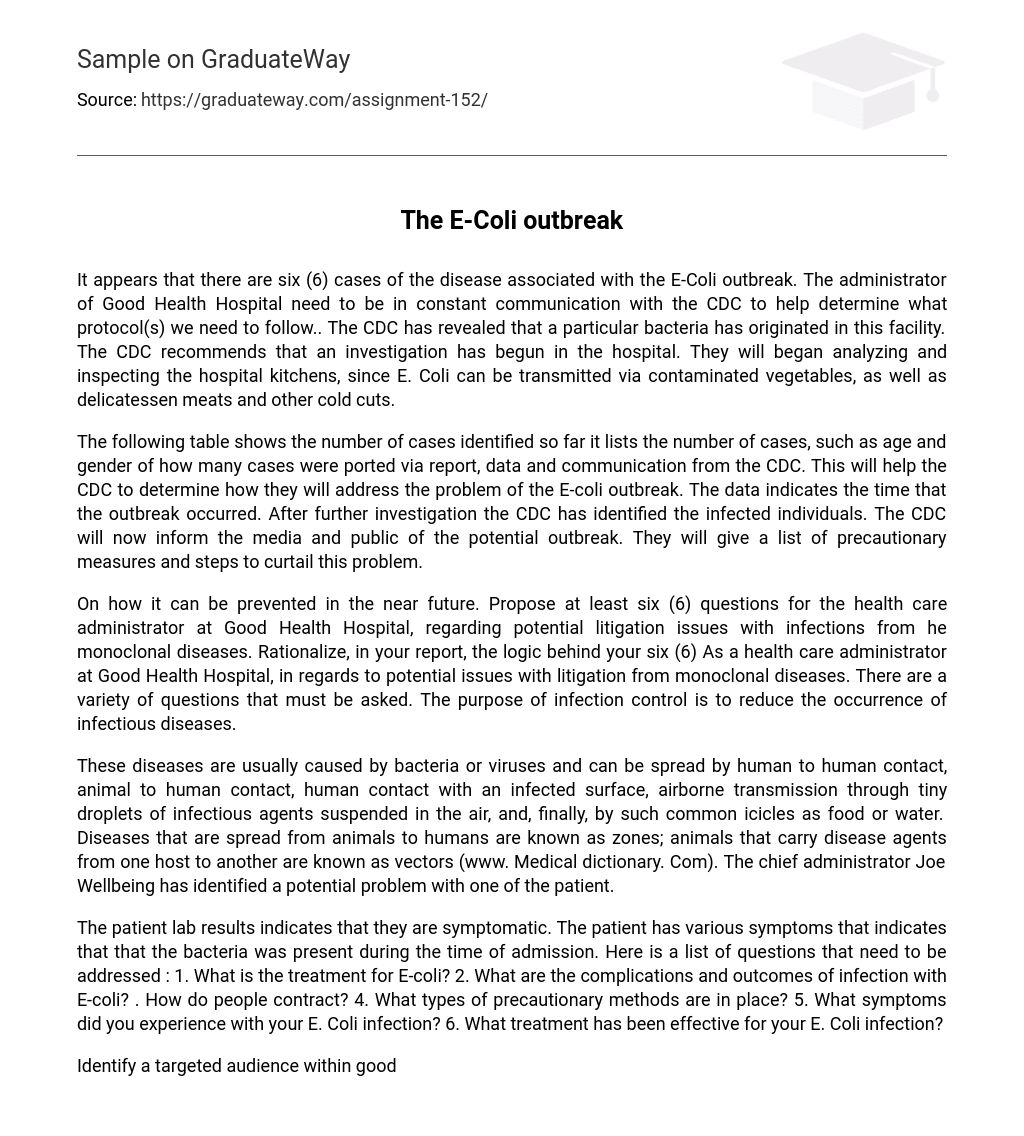According to reports, there are six (6) cases of the disease associated with the E-Coli outbreak. To establish the necessary protocol(s), continuous communication between the administrator of Good Health Hospital and the CDC is essential. The CDC has disclosed that a specific bacteria has emerged in this facility and advises initiating an investigation. This inquiry will involve inspecting and examining the hospital kitchens as E. Coli can be transmitted through contaminated vegetables, deli meats, and other cold cuts.
The following table displays the current count of reported cases, encompassing age and gender information. This data has been shared with the CDC to aid in their response to the E-coli outbreak. It also highlights the timeframe during which the outbreak transpired. Following a comprehensive inquiry, the CDC has identified those impacted and intends to notify both the media and public regarding this potential outbreak. Furthermore, they will furnish a compilation of preventive measures and steps aimed at mitigating this issue.
To avoid potential litigation issues related to infections caused by monoclonal diseases, it is vital to ask the health care administrator at Good Health Hospital a minimum of six (6) questions. As a health care administrator, understanding the rationale behind these questions is essential for preventing similar problems in the future. The primary objective of infection control is to reduce the occurrence of infectious diseases.
These diseases are usually caused by bacteria or viruses and can be spread through different methods such as human-to-human contact, animal-to-human contact, human contact with infected surfaces, airborne transmission via small droplets of infectious agents in the air, and also through common vehicles like food or water. Diseases transmitted from animals to humans are known as zoonotic diseases; animals that transmit disease agents from one host to another are called vectors (www.medicaldictionary.com). Joe Wellbeing, the chief administrator, has detected a possible problem with one of the patients.
The patient’s lab results indicate the presence of bacteria upon admission, showing symptoms of E-coli infection. The following questions need to be answered and addressed: 1. What is the treatment for E-coli? 2. What are the complications and outcomes of E-coli infection? 3. How do people contract E-coli? 4. What precautionary methods are in place? 5. What symptoms did you experience with your E. Coli infection? 6. What treatment has been effective for your E. Coli infection?
In a hypothetical meeting with the healthcare administrator of the hospital, an implementation plan will be created to target healthcare workers at risk of exposure to infectious diseases. This includes doctors, nurses, technicians, clinical laboratory staff, first responders, maintenance personnel, security and administrative staff, social workers, food service workers, housekeeping staff, and mortuary personnel within Good Health Hospital.
Workers in various workplace settings, such as hospitals, nursing care facilities, outpatient clinics (e.g., medical and dental offices, and occupational health clinics), ambulatory care centers, and emergency response settings contribute to the diversity among Haws and their workplaces. This poses a challenge in terms of occupational exposure to infectious diseases (www.Siebel.Org/patients_visitors/patient_safety).
To address this challenge, a strategic plan has been implemented after consultation with the chief administrator. The plan involves developing, evaluating, and disseminating tools for identifying and understanding emerging infectious diseases. It also includes identifying behaviors, environments, and host factors that increase the risk of such diseases. Additionally, research is conducted in nine specific areas to develop and assess prevention and control strategies.
Efforts are made to enhance epidemiological and laboratory capacity as well as improve communication between Cad state/local health departments U.S. Quarantine stations healthcare professionals electronically. Measures are taken to enhance the nation’s ability to respond to complex infectious disease threats both domestically in the United States and internationally including outbreaks from baptisteries.
Training in infectious disease epidemiology and diagnosis is available both domestically within the United States and internationally.
The responsibilities of overseeing the implementation of the infection control program include reviewing and approving a yearly program of activities for surveillance and prevention. Additionally, it involves reviewing epidemiological surveillance data to identify areas for intervention. Another important task is developing hospital policies for the prevention and control of infection. It is also necessary to assess and promote improved practice at all levels of the health facility. This includes ensuring appropriate staff training in infection control and safety management, as well as providing safety materials like personal protective equipment. Additionally, organizing the training of Haws is part of the responsibilities.





